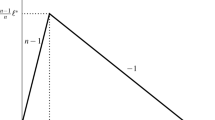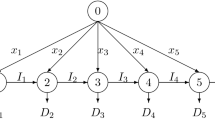Abstract
In this paper, we deal with the production scheduling ofseveral products that are produced periodically, in a fixed sequence, ona single machine. In the literature, this problem is usually referred to asthe Common Cycle Economic Lot Scheduling Problem. We extend thelatter to allow the production rates to be controllable at the beginningof as well as during each production run of a product. Also, we assumethat unsatisfied demand is completely backordered. The objective is todetermine the optimal schedule that satisfies the demand for all theproducts and that realizes the minimum average setup, inventoryholding and backlog cost per unit time. Comparison with previousresults (when production rates are fixed) reveals that averagecosts can be reduced up to 66% by allowing controllable productionrates.
Similar content being viewed by others
References
Arizono, I., Yokoi, S. and Ohta, H. (1989), The Effects of Varying Production Rates on Inventory Control, Journal of Operational Research Society, 40, 789–796.
Axsäter, S. (1985), Performance Bounds for Lot Sizing Heuristics, Management Science 31, 634–640.
Bai, S. X. and Elhafsi, M. (1996) Transient and Steady State Analysis of a Manufacturing System with Setup Changes, Journal Of Global Optimization 8, 349–378.
Bazaraa, M. S. and Shetty, C. M. (1979) NonLinear Programming Theory and Algorithms. John Wiley & Sons.
Boctor, F. F. (1982), The Two-Product, Single-Machine, Static-Demand, Infinite Horizon Lot Scheduling Problem, Management Science, 28, 798–807.
Bomberger, E. (1966), A Dynamic Programming Approach to a Lot Scheduling Problem, Management Science 12, 778–784.
Buzacott, J. A., Ozkarahan, I. A. (1983), One-and Two-Stage Scheduling of Two Products with Distributed Inserted Idle Time: The Benefits of a Controllable Production Rate, Naval Research Logistics Quarterly, 30, 675–696.
Carreno, J. J. (1990), Economic Lot Scheduling for Multiple Products on Parallel Identical Processors, Management Science 36, 348–358.
Dobson, G. (1987), The Economic Lot Scheduling Problem: Achieving Feasibility Using Time-Varying Lot Sizes, Operations Research 35, 764–771.
Elhafsi, M. and Bai, S. X. (1996), Optimal Production Control of a Dynamic Two-Product Manufacturing System with Setup Costs and Setup Times, Journal Of Global Optimization 9, 183–216.
Elmaghraby, S. E. (1978), The Economic Lot Scheduling Problem (ELSP): Review and Extensions, Management Science 24, 587–598.
Gallego, G. (1989), Real-Time Scheduling of Several Products on a Single FacilityWith Setups and Backorders, Ph.D. Thesis, School of OR&IE, Cornell University, Ithaca, NY.
Goyal, S. K. (1984), Determination of Economic Production Quantities for a Two-Product Single Machine System, International Journal of Production Research. 22, 121–126.
Hsu, W. L. (1983), On the General Feasibility Test of Scheduling Lot Sizes for Several Products on One Machine, Management Science 29, 93–105.
Jones, P. and Inman, R. (1989), When is the Economic Lot Scheduling Problem easy?, IIE Transactions 21, 11–20.
Kushner, H. J. and Dupuis, P. G. (1992), Numerical Methods for Stochastic Control Problems in Continuous Time. Springer-Verlag.
Lee, C.Y. and Surya, D. (1989), Economic Lot Scheduling for Two-Product Problem, IIE Transactions 21, 162–169.
Maxwell, W. L. and Singh, H. (1983), The Effect of Restricting Cycle Times in The Economic Lot Scheduling Problem, IIE Transactions 15, 235–241.
Moon, I., Gallego, G. and Simchi-Levi, D. (1991), Controllable Production Rates in a Family Context, International Journal of Production Research 29, 2459–2470.
Roundy, R. (1985), 98%-Effective Integer-Ratio Lot Sizing for One-Warehouse Multi-Retailer Systems, Management Science 31, 1416–1430.
Silver, E. (1990), Deliberately Slowing Down Output in a Family Production Context, International Journal of Production Research 28, 17–27.
Zipkin, P. (1991), Computing Optimal Lot Sizes in the Economic Lot Scheduling Problem, Operations Research 39, 53–63.
Author information
Authors and Affiliations
Rights and permissions
About this article
Cite this article
elhafsi, M., Bai, S.X. The Common Cycle Economic Lot Scheduling Problem with Backorders: Benefits of Controllable Production Rates. Journal of Global Optimization 10, 283–303 (1997). https://doi.org/10.1023/A:1008253107528
Issue Date:
DOI: https://doi.org/10.1023/A:1008253107528




